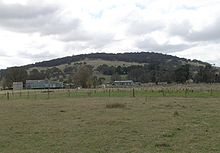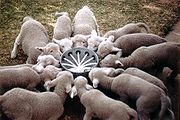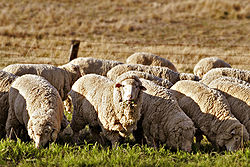
Sheep station
Encyclopedia

.jpg)


Station (Australian agriculture)
Station is the term for a large Australian landholding used for livestock production. It corresponds to the North American term ranch or South American estancia...
, the equivalent of a ranch
Ranch
A ranch is an area of landscape, including various structures, given primarily to the practice of ranching, the practice of raising grazing livestock such as cattle or sheep for meat or wool. The word most often applies to livestock-raising operations in the western United States and Canada, though...
) in Australia
Australia
Australia , officially the Commonwealth of Australia, is a country in the Southern Hemisphere comprising the mainland of the Australian continent, the island of Tasmania, and numerous smaller islands in the Indian and Pacific Oceans. It is the world's sixth-largest country by total area...
or New Zealand
New Zealand
New Zealand is an island country in the south-western Pacific Ocean comprising two main landmasses and numerous smaller islands. The country is situated some east of Australia across the Tasman Sea, and roughly south of the Pacific island nations of New Caledonia, Fiji, and Tonga...
whose main activity is the raising of sheep
Domestic sheep
Sheep are quadrupedal, ruminant mammals typically kept as livestock. Like all ruminants, sheep are members of the order Artiodactyla, the even-toed ungulates. Although the name "sheep" applies to many species in the genus Ovis, in everyday usage it almost always refers to Ovis aries...
for their wool
Wool
Wool is the textile fiber obtained from sheep and certain other animals, including cashmere from goats, mohair from goats, qiviut from muskoxen, vicuña, alpaca, camel from animals in the camel family, and angora from rabbits....
and meat
Meat
Meat is animal flesh that is used as food. Most often, this means the skeletal muscle and associated fat and other tissues, but it may also describe other edible tissues such as organs and offal...
. In Australia, sheep stations are usually in the south-east or south-west of the country. In New Zealand the Merino
Merino
The Merino is an economically influential breed of sheep prized for its wool. Merinos are regarded as having some of the finest and softest wool of any sheep...
s are usually in the high country
High country (New Zealand)
High country is a New Zealand term for the elevated pastoral land of the South Island and - to a lesser extent - North Island of New Zealand. This terrain, which can be compared loosely with the outback of Australia, high veldt of South Africa and pampas of Argentina, lies in the rain shadow of the...
of the South Island
South Island
The South Island is the larger of the two major islands of New Zealand, the other being the more populous North Island. It is bordered to the north by Cook Strait, to the west by the Tasman Sea, to the south and east by the Pacific Ocean...
. These properties may be thousands of square kilometres in size and run low stocking rates to be able to sustainably provide enough feed and water for the stock.
In Australia, the owner of a sheep station is called a grazier; or formerly, a squatter
Squatting (pastoral)
In Australian history, a squatter was one who occupied a large tract of Crown land in order to graze livestock. Initially often having no legal rights to the land, they gained its usage by being the first Europeans in the area....
, as in Waltzing Matilda
Waltzing Matilda
"Waltzing Matilda" is Australia's most widely known bush ballad. A country folk song, the song has been referred to as "the unofficial national anthem of Australia"....
.
In the Australian and New Zealand context, shearing involves an annual muster of sheep to be shorn, and the shearing shed
Shearing shed
Shearing sheds are large sheds located on sheep stations to accommodate large scale sheep shearing activities.In countries where large numbers of sheep are kept for wool, sometimes many thousands in a flock, shearing sheds are vital to house the necessary shearing equipment, and to ensure that the...
and shearers' quarters are an important part of the station. A station usually also includes a homestead
Homestead (buildings)
A homestead is either a single building, or collection of buildings grouped together on a large agricultural holding, such as a ranch, station or a large agricultural operation of some other designation.-See also:* Farm house* Homestead Act...
, adjacent sheds, windmills, dams, silos and in many cases a landing strip available for use by the Royal Flying Doctor Service and other light aircraft. Some of these items have regional variants, usually to deal with climate extremes.
Similarly, where the climate and vegetation allow, especially north of the dog fence, cattle station
Cattle station
Cattle station is an Australian term for a large farm , whose main activity is the rearing of cattle. In Australia, the owner of a cattle station is called a grazier...
s are similar but run beef cattle rather than sheep. Some properties are not exclusively sheep or cattle stations but may have a mix of cattle, sheep, cropping and even goats which makes the owner less vulnerable to changes in wool or beef prices.
Walter Peak is a notable old sheep station that was founded in 1860 on the south shore of Lake Wakatipu
Lake Wakatipu
Lake Wakatipu is an inland lake in the South Island of New Zealand. It is in the southwest corner of Otago Region, near its boundary with Southland.With a length of , it is New Zealand's longest lake, and, at , its third largest...
, South Island, New Zealand. It is 13 kilometres across Lake Wakatipu from Queenstown, 40 minutes steaming time on the historic TSS Earnslaw steamship.
Management of a sheep station
Management practices vary according to the location of the station and the season being experienced. For instance, droughtDrought
A drought is an extended period of months or years when a region notes a deficiency in its water supply. Generally, this occurs when a region receives consistently below average precipitation. It can have a substantial impact on the ecosystem and agriculture of the affected region...
necessitates decisions concerning the sale of stock or provision of supplementary feeding.
Routine procedures include supervising crutching
Crutching
Crutching refers to the removal of wool from around the tail and between the rear legs of a sheep. It can also refer to removing wool from the heads of sheep or from the bellies of male sheep .-Motivation:...
, mating, shearing
Sheep shearing
Sheep shearing, shearing or clipping is the process by which the woollen fleece of a sheep is cut off. The person who removes the sheep's wool is called a shearer. Typically each adult sheep is shorn once each year...
, treating for tick
Tick
Ticks are small arachnids in the order Ixodida, along with mites, constitute the subclass Acarina. Ticks are ectoparasites , living by hematophagy on the blood of mammals, birds, and sometimes reptiles and amphibians...
s, lice and maggot
Maggot
In everyday speech the word maggot means the larva of a fly ; it is applied in particular to the larvae of Brachyceran flies, such as houseflies, cheese flies, and blowflies, rather than larvae of the Nematocera, such as mosquitoes and Crane flies...
s (if necessary), lambing and lamb marking. Lambs are weaned at about five months of age. Drenching
Deworming
Deworming is the giving of an anthelmintic drug to an animal to rid it of intestinal parasites, such as roundworm and tapeworm...
for internal parasites
Parasitism
Parasitism is a type of symbiotic relationship between organisms of different species where one organism, the parasite, benefits at the expense of the other, the host. Traditionally parasite referred to organisms with lifestages that needed more than one host . These are now called macroparasites...
is an important routine on a sheep station.
Other activities include ram buying and classing the sheep in order to determine the inferior types that are to be culled.
Crops and pastures are often also grown to provide additional feed for the sheep, especially those that will be raised and sold as prime lambs. Fences require regular inspections to locate and repair any damage that has been found. Sheep breeders may also need to undertake predatory animal control if crows, dingo
Dingo
The Australian Dingo or Warrigal is a free-roaming wild dog unique to the continent of Australia, mainly found in the outback. Its original ancestors are thought to have arrived with humans from southeast Asia thousands of years ago, when dogs were still relatively undomesticated and closer to...
s or fox
Fox
Fox is a common name for many species of omnivorous mammals belonging to the Canidae family. Foxes are small to medium-sized canids , characterized by possessing a long narrow snout, and a bushy tail .Members of about 37 species are referred to as foxes, of which only 12 species actually belong to...
es are likely to be a problem.
Language use
The term generally used by agricultural and environmental professionals for sheep station forms of landholding is rangelandRangeland
Rangelands are vast natural landscapes in the form of grasslands, shrublands, woodlands, wetlands, and deserts. Types of rangelands include tallgrass and shortgrass prairies, desert grasslands and shrublands, woodlands, savannas, chaparrals, steppes, and tundras...
, but is not in general use by Australians. The term ranch is rarely, if ever, used. The term sheep run was also commonly used during the early settlement period to describe sheep stations operated by squatters
Squatting (pastoral)
In Australian history, a squatter was one who occupied a large tract of Crown land in order to graze livestock. Initially often having no legal rights to the land, they gained its usage by being the first Europeans in the area....
.
For administrative purposes, many stations exist on pastoral lease
Pastoral lease
A pastoral lease is Crown land that government allows to be leased, generally for the purposes of farming.-Australia:Pastoral leases exist in both Australian commonwealth law and state jurisdictions....
s, but in state government jurisdictions they are increasingly known as stations.
The word station is also a traditional Australian English
Australian English
Australian English is the name given to the group of dialects spoken in Australia that form a major variety of the English language....
term to denote a large and/or important landholding for any agricultural purpose.
The term Playing for sheep stations
Playing for sheep stations
The phrase is a traditional Australian English term to denote something large and/or important. A sheep station is a large sheep farm in Australia or New Zealand....
is used to denote a large or serious game.
Books
Two well-known nineteenth century authors have written about life on a sheep station:- Lady BarkerMary Anne BarkerMary Anne Barker, Lady Barker , later Mary Anne Broome, Lady Broome, was an author.-Biography:Born Mary Anne Stewart in Spanish Town, Jamaica, she was the eldest daughter of Walter Steward, Island Secretary of Jamaica...
Station Life in New Zealand and Station Amusements in New Zealand. - Samuel ButlerSamuel Butler (novelist)Samuel Butler was an iconoclastic Victorian author who published a variety of works. Two of his most famous pieces are the Utopian satire Erewhon and a semi-autobiographical novel published posthumously, The Way of All Flesh...
A First Year in the Canterbury Settlement and his novel ErewhonErewhonErewhon: or, Over the Range is a novel by Samuel Butler, published anonymously in 1872. The title is also the name of a country, supposedly discovered by the protagonist. In the novel, it is not revealed in which part of the world Erewhon is, but it is clear that it is a fictional country...
.
See also
- Cattle stationCattle stationCattle station is an Australian term for a large farm , whose main activity is the rearing of cattle. In Australia, the owner of a cattle station is called a grazier...
- List of pastoral leases in Western Australia
- List of ranches and stations
- Pastoral leasePastoral leaseA pastoral lease is Crown land that government allows to be leased, generally for the purposes of farming.-Australia:Pastoral leases exist in both Australian commonwealth law and state jurisdictions....
- RangelandRangelandRangelands are vast natural landscapes in the form of grasslands, shrublands, woodlands, wetlands, and deserts. Types of rangelands include tallgrass and shortgrass prairies, desert grasslands and shrublands, woodlands, savannas, chaparrals, steppes, and tundras...
- Sheep husbandrySheep husbandrySheep husbandry is a subcategory of animal husbandry specifically dealing with the raising and breeding of domestic sheep. Sheep farming is primarily based on raising lambs for meat, or raising sheep for wool. Sheep may also be raised for milk or to sell to other farmers.-Shelter and...
- Sheep shearingSheep shearingSheep shearing, shearing or clipping is the process by which the woollen fleece of a sheep is cut off. The person who removes the sheep's wool is called a shearer. Typically each adult sheep is shorn once each year...
- Station (Australian agriculture)Station (Australian agriculture)Station is the term for a large Australian landholding used for livestock production. It corresponds to the North American term ranch or South American estancia...
- Station (New Zealand agriculture)Station (New Zealand agriculture)A station, in the context of New Zealand agriculture, is a large farm dedicated to the grazing of sheep and cattle. The use of the word for the farm or farm buildings date back to the mid-nineteenth century....
- Stockman (Australia)
External links
- Tobruk Sheep Station — includes photo of stockman mustering sheep
- Sheep-dipping on the Orari Gorge Station (photo c1899)

